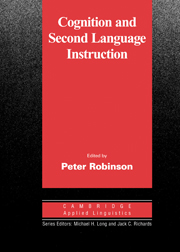Book contents
- Frontmatter
- Contents
- Series editors' preface
- Preface
- SECTION I THEORETICAL ISSUES
- 1 Attention
- 2 Memory for language
- 3 The competition model: the input, the context, and the brain
- 4 Sentence processing
- 5 Automaticity and automatization
- 6 Learnability and second language acquisition theory
- SECTION II COGNITION AND INSTRUCTION
- References
- Index
5 - Automaticity and automatization
Published online by Cambridge University Press: 05 October 2012
- Frontmatter
- Contents
- Series editors' preface
- Preface
- SECTION I THEORETICAL ISSUES
- 1 Attention
- 2 Memory for language
- 3 The competition model: the input, the context, and the brain
- 4 Sentence processing
- 5 Automaticity and automatization
- 6 Learnability and second language acquisition theory
- SECTION II COGNITION AND INSTRUCTION
- References
- Index
Summary
Introduction: concepts and issues
In a very general sense, everybody knows what automaticity means. Some doors slide open automatically, some cars shift gears automatically, some VCRs rewind automatically; in other words these objects perform their functions without requiring any physical or mental effort on our part (the meaning of the Greek adjective automatos is selfacting). In the psychological sense, every layman has had experience with automaticity too. When typing, driving a stick-shift car or using a word-processor too edit a text, we perform a complex series of tasks very quickly and efficiently, without having to think about the various components and subcomponents of action involved; sometimes we are even unable to think of them explicitly, and therefore we may have trouble visualizing the keyboard or explaining to somebody else how to use a piece of software, even though – or rather just because – we use the keyboard or the software with great ease. Initially, though, we may have found typing, driving a stick-shift car or using a spreadsheet to be slow, tricky, and tiring. The automaticity, that is the speed and ease with which we ultimately carry out these tasks, is the result of a slow process that we call automatization. Once this process has run its course, the chain of actions involved in the automatized tasks can even become hard to suppress, as we experience when forced to shift from a querty to an azerty keyboard, from a stick-shift to an automatic car, or from one kind of accounting software to another.
- Type
- Chapter
- Information
- Cognition and Second Language Instruction , pp. 125 - 151Publisher: Cambridge University PressPrint publication year: 2001
- 141
- Cited by

